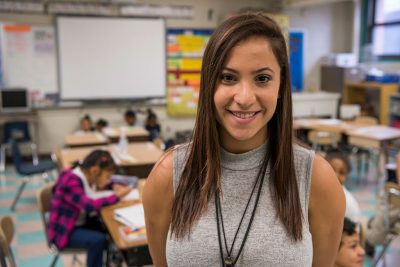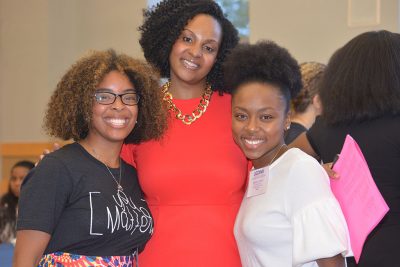This webpage is in the process of being updated. Please check back later.

Thanks to a newly announced investment of $240,000 from the William Caspar Graustein Memorial Fund, the Neag School will be able to support further efforts to diversify the teacher workforce of tomorrow.
Students of color currently represent 46 percent of students in U.S. K-12 public schools, yet the nation’s educator workforce does not mirror the current student population. Whereas white teachers make up 82 percent of the teacher workforce nationwide, black and Latinx teachers comprise just 15 percent. In the state of Connecticut, where, incidentally, the achievement gap is the largest in the nation, teachers of color make up only about 9 percent of the educator workforce.
Research findings, meanwhile, suggest that positive outcomes for students result in part from a diverse teaching workforce. For instance, a recently released study co-authored by Joshua Hyman, assistant professor with a joint appointment in the Neag School, found that black students who have had at least one black teacher in elementary school were not only more likely to graduate high school, but also more likely to go to college. In addition, diversifying the teaching workforce in turn plays a key role in diversifying the educator population in other areas of education, such as school counseling and school administration, as these professional pipelines typically come from those in the teacher ranks.
“Students of color benefit from having teachers of color,” Neag School Dean Gladis Kersaint recently told UConn Today.“It’s not just students of color, though. Research supports that all students, no matter what race, benefit from having teachers of color.” She cites one 2016 study’s findings that students of all races more favorably perceive teachers of color versus white teachers.
“Making sure that there is a diverse array of teachers for students to learn from and relate to is of critical importance to the success of the education pipeline in communities of color.”
— David Addams, executive director, William Caspar Graustein Memorial Fund
Support for the Education Pipeline
For students who aspire to be teachers, obtaining education credentials comes with additional costs that students pursuing college degrees in other areas do not typically encounter — from paying licensure exam, background check, and fingerprinting fees required by schools to covering other extra expenses, such as transportation to internships and student-teacher clinical placements in local school districts.
The grant from the Graustein Memorial Fund, whose mission is to achieve equity in education, will be used specifically to provide stipends to students of color enrolled in the Neag School’s Integrated Bachelor’s/Master’s (IB/M) program, through which students earn a bachelor’s degree in education as well as a master’s degree, either in curriculum and instruction or educational psychology, within five years. Ten students of color will receive $2,000 apiece for each year of enrollment in the IB/M program to help cover the extra costs associated with earning degrees in teaching. The Graustein grant will fund these stipends for three cohorts of students, beginning this fall, as the Neag School seeks to secure additional financial support to continue this effort beyond 2021.
The Graustein grant will also provide stipends to practicing teachers of color interested in serving as mentors to these students. A $2,000 stipend per year per mentor will help cover the costs of, for example, planning and implementing various networking programs and community activities intended to provide mentees opportunities to connect with educators of color.
“Making sure that there is a diverse array of teachers for students to learn from and relate to is of critical importance to the success of the education pipeline in communities of color,” says David Addams, executive director of the William Caspar Graustein Memorial Fund. “Our decision to partner with the Neag School as a primary source of educators in the state is one of optimism about their approach and commitment to the goals of equity in education and ending racism and poverty.”

Transforming the Educator Workforce
At the same time, the Connecticut State Department of Education (CSDE), says Sarah Barzee, chief talent officer at CSDE and alumna of the Neag School’s Executive Leadership Program, is also “committed to increasing the racial, ethnic, and linguistic diversity of the state’s educator workforce through efforts to remove barriers, create more pathways for college graduates and mid-career professionals to enter the teaching profession, and provide mentoring support to early career teachers.”
“The support of the Graustein Memorial Fund,” she says, “will enable the Neag School of Education, a key partner with CSDE in these efforts, to achieve our shared vision to recruit, prepare, certify, develop, and retain an educator workforce that reflects Connecticut’s diverse student population and encourages more students of color to pursue a career in teaching.”
The Neag School has been active in working to diversify its teacher education program student population through numerous strategic recruitment and retention initiatives. In 2014, for example, the School joined the American Association of Colleges for Teacher Education’s Networked Improvement Community, an effort to collaborate with other institutions nationwide on strategies to bring more Black and Latino men into teacher education programs. In addition, the Neag School partners with Leadership in Diversity, a student-led organization, on a program called Diverse Educators Making Outstanding Change (D.E.M.O.). This mentoring program seeks to improve achievement, retention, and engagement among students of color in the Neag School’s pre-teaching and teaching programs by bringing students enrolled (or those with an interest in enrolling) in the IB/M Program together with professional educators and school administrators in the community.
The Neag School also hosts an annual Celebration of Diversity in Education Dinner, which gives the Neag School’s pre-teaching and current teacher education students of color an opportunity to meet with peers, alumni, staff, faculty, and education professionals to network, ask questions, and gain new insights.
Collectively, these efforts, among others, have yielded positive results: Over the past two years alone, the percentage of students of color enrolled in the IB/M bachelor’s program have increased by 10 percent.
“The Graustein Fund represents a significant and welcome source of support for Neag School students aspiring to lead careers in education,” says Dean Kersaint. “Whether through grants, scholarships, or other funding sources, we are continually looking to find funding support to help prospective teachers enrolled in the IB/M, as well as our Teacher Certification Program for College Graduates, defray the costs that come with pursuing a career path in teaching. Such support remains vital to our students and, ultimately, to transforming the educator workforce.”
Learn more about the William Caspar Graustein Memorial Fund at wcgmf.org.
Related Stories:
- UConn Increases Diversity in Teaching Programs
- Future Teachers Unite With Education Professionals in Neag School Mentoring Program
- Students of Color, Neag School Faculty Partner to Boost Diversity Among Aspiring Educators
- National Teacher of the Year Gives Words of Encouragement to Current and Future Educators
 Facebook
Facebook
 Twitter
Twitter
 LinkedIn
LinkedIn
